
Boost Your Wellness: Discover the Best 5 Chair Yoga Poses
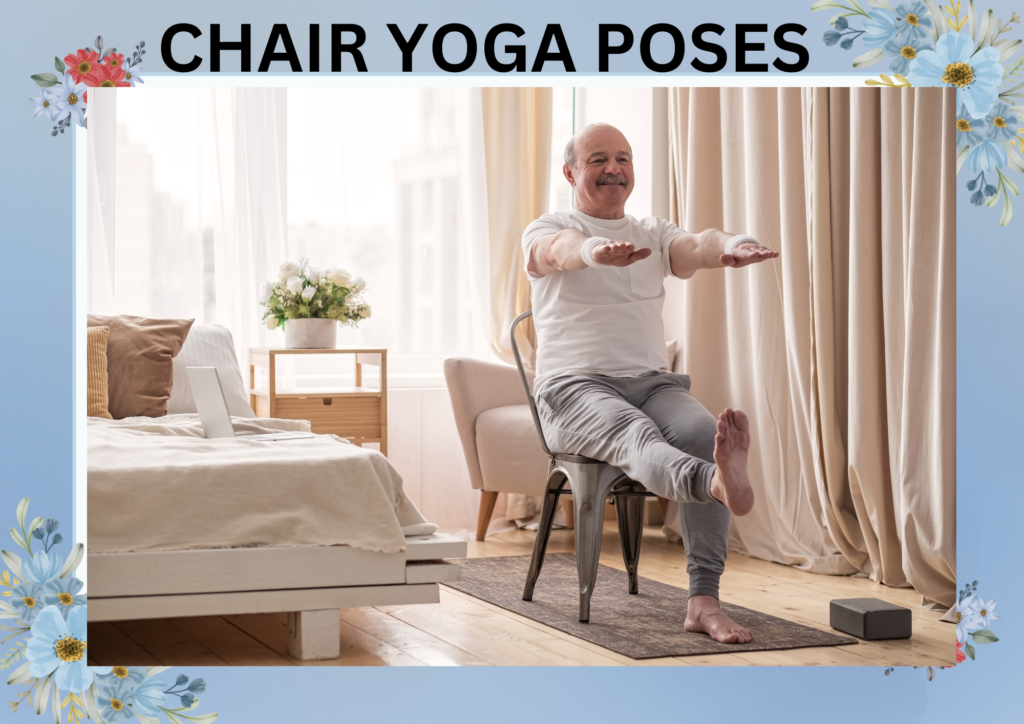 The modern work environment often keeps us glued to our chairs for extended periods. While deadlines loom and inboxes overflow, our bodies crave movement and stretch to stay limber and energized. This is where chair yoga comes in – a fantastic way to incorporate gentle yoga postures right at your desk, promoting physical and mental well-being throughout the workday.
The modern work environment often keeps us glued to our chairs for extended periods. While deadlines loom and inboxes overflow, our bodies crave movement and stretch to stay limber and energized. This is where chair yoga comes in – a fantastic way to incorporate gentle yoga postures right at your desk, promoting physical and mental well-being throughout the workday.
The Magic of Chair Yoga
Chair yoga offers a multitude of benefits that go beyond just a quick desk break. Here’s what you can expect:
Improved Mobility and Flexibility: Sitting for long stretches tightens muscles and reduces your range of motion. Chair yoga poses to target specific muscle groups, gently stretching and increasing flexibility, leaving you feeling looser and less achy.
Enhanced Posture and Core Strength: Poor posture is a common consequence of desk jobs. Chair yoga helps strengthen core muscles, leading to better spinal alignment and improved posture.
Increased Blood Flow and Circulation: Long periods of sitting can restrict blood flow. Chair yoga poses incorporating arm movements and leg stretches help increase circulation, keeping you feeling energized and focused.
Stress Reduction and Mental Clarity: Holding a single position for extended periods can lead to mental fatigue. Chair yoga incorporates mindful breathing techniques and gentle stretches, promoting relaxation and improving mental clarity.
Boosted Energy Levels: The gentle movements and stretches involved in chair yoga help combat sluggishness and fatigue, leaving you feeling rejuvenated and ready to tackle your tasks.
The Perfect 5-Pose Chair Yoga Routine for Your Workday
Here are five fantastic chair yoga poses you can easily incorporate into your workday, no matter your fitness level. Remember to listen to your body and modify the poses as needed.
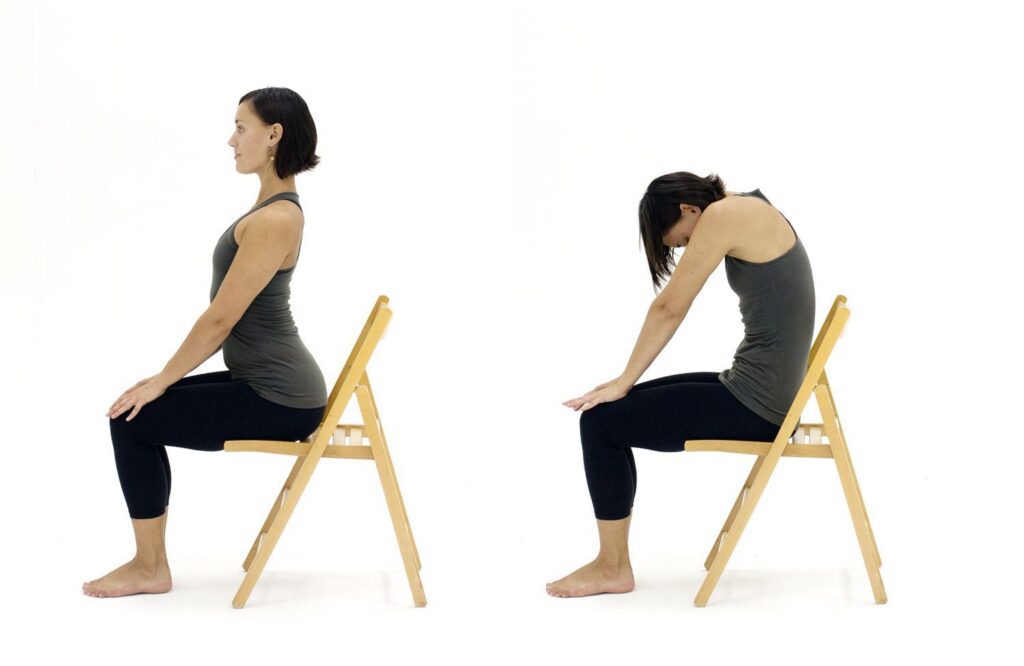
-
Seated Cat-Cow (Marjaryasana-Bitilasana):
This dynamic pose warms up your spine and improves flexibility.
Sit tall on the edge of your chair with your feet hip-width apart and hands resting on your thighs.
Inhale, arch your back gently, push your chest forward, and drop your head back (only if comfortable). This is the cow pose (Bitilasana).
Exhale, round your back, tuck your chin to your chest and engage your abdominal muscles. This is a cat pose (Marjaryasana).
Repeat this movement for 5-10 breaths, focusing on a smooth and coordinated inhale-exhale cycle.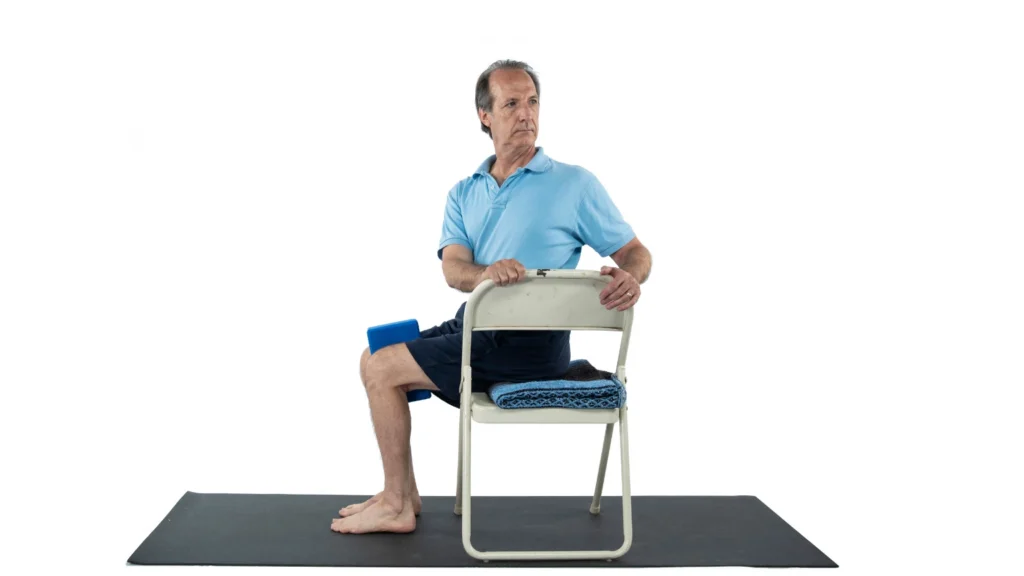
-
Seated Twist (Parivrtta Tadasana):
This pose targets your core and improves spinal mobility.
Sit tall on your chair with your feet flat on the floor.
Inhale, reach your left arm up towards the ceiling.
Exhale, twist your torso to the right, placing your left hand on the back of your chair for support.
Keep your gaze looking over your right shoulder. Hold for five breaths, then repeat on the other side.
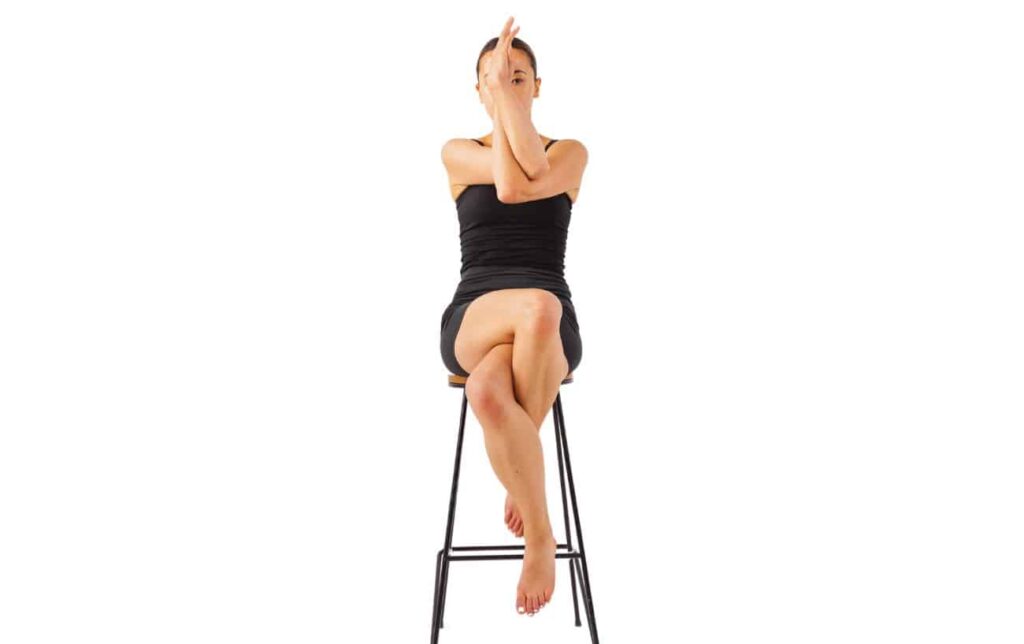
-
Seated Eagle Arms (Garudasana Arms):
This pose opens up your shoulders and improves upper body posture.
Sit tall on your chair with your feet flat on the floor.
Inhale, reach your arms out to the sides at shoulder height.
Cross your right arm over your left forearm, bringing your palms together (or as close as comfortable) at your chest level.
Gently press your forearms against each other. Hold for five breaths, then repeat with the other arm on top.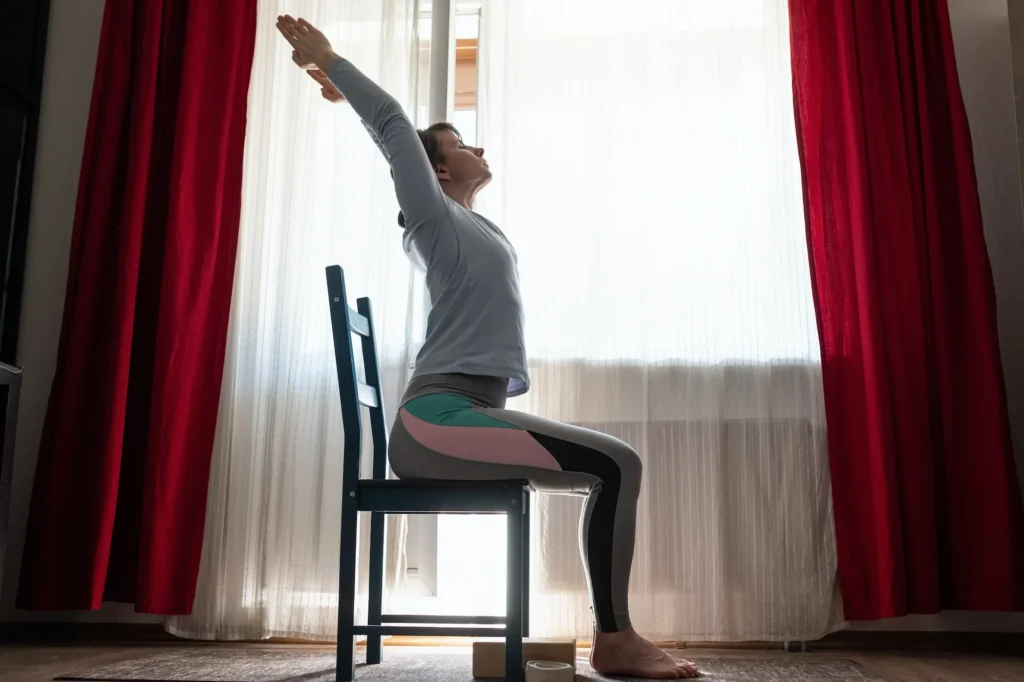
-
Seated Mountain Pose with Arm Raises (Tadasana Variation):
This pose strengthens your core and improves balance.
Sit tall on the edge of your chair with your feet hip-width apart and core-engaged.
Inhale, raise your arms overhead, reaching your fingertips towards the ceiling.
Interlace your fingers, palms facing forward.
Hold for five breaths, focusing on maintaining a long spine and keeping your core engaged. Exhale, slowly lower your arms back down to your sides.
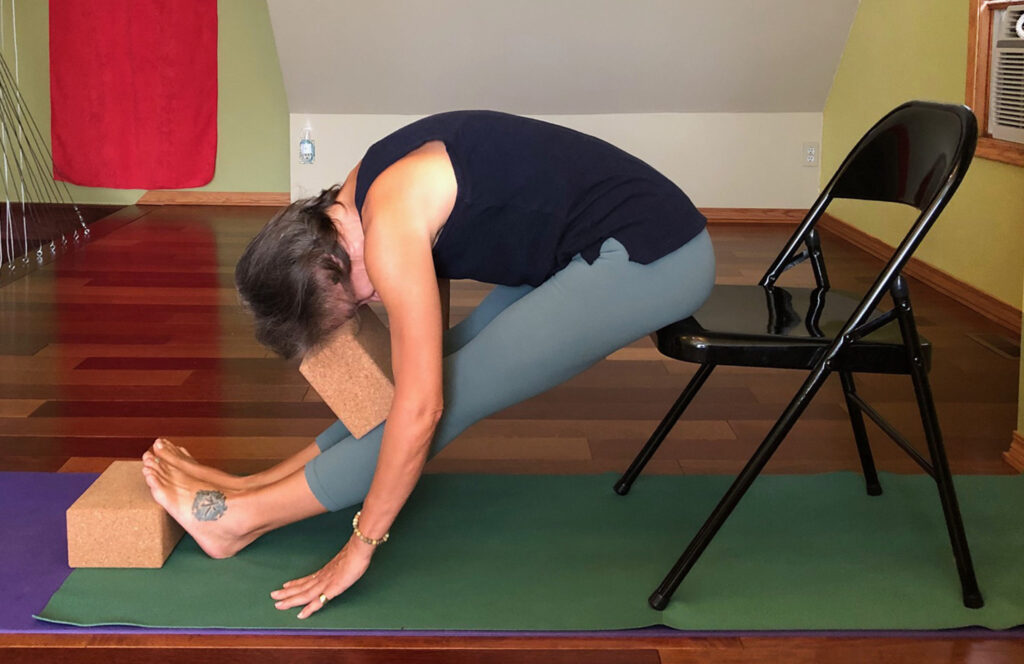
-
Seated Forward Fold (Paschimottanasana):
This pose stretches your hamstrings and lower back.
Sit tall on your chair with your feet flat on the floor.
Inhale, lengthen your spine.
Exhale, hinge at your hips, and gently fold forward, reaching your hands towards your shins or the floor (as far as comfortable).
Keep your back straight and avoid rounding your shoulders.
Hold for five breaths, focusing on your breath and the gentle stretch in your hamstrings.
Inhale and slowly come back up to a seated position.
Tips for a Successful Chair Yoga Practice
Find a Stable Chair: Use a sturdy chair with a backrest for added support.
Maintain Proper Posture: Keep your back straight, shoulders relaxed, and core engaged throughout the poses.
Focus on Your Breath: Breathe deeply and evenly throughout each pose. Inhale as you lengthen and expand, exhale as you release or twist.
Listen to Your Body: Don’t push yourself beyond your limits. Modify the poses as needed to avoid any discomfort or pain.
Take Breaks and Repeat: Aim for short but frequent breaks throughout the day. You can repeat this entire sequence or choose a few poses to focus on.
Make it Fun!: Put on some relaxing music or find a quiet corner of your office. Enjoy the gentle movements and feel the positive effects on your body and mind.
Chair Yoga: A Gateway to a Healthier You
Chair yoga is a simple yet powerful tool to integrate movement and mindfulness into your workday. By incorporating these poses into your routine, you can combat the negative effects of prolonged sitting, boost your energy levels, improve your focus, and reduce stress. Remember, consistency is key. The more you practice chair yoga, the more you’ll experience its benefits and feel the difference in your overall well-being.
Beyond the Desk: Expanding Your Practice
While chair yoga offers a convenient way to move your body at work, it can also be a stepping stone to a more comprehensive yoga practice. If you enjoy the benefits of chair yoga, consider exploring other beginner-friendly yoga styles. Many studios offer classes specifically designed for beginners, or you can find online resources to guide you through a full yoga routine at home.
So, the next time you feel that afternoon slump settling in, take a moment for yourself. Roll out your chair yoga routine, focus on your breath, and feel the revitalizing effects on your body and mind. You might be surprised at how a few simple poses can make a big difference in your workday and overall well-being.
FAQs about Chair Yoga Poses:
- What is chair yoga, and how does it differ from traditional yoga?
Chair yoga is a modified form of yoga that is performed while seated on a chair or using a chair for support. It is designed to make yoga accessible to individuals with mobility issues, limited flexibility, or those who prefer a gentler practice. While traditional yoga is typically practiced on a mat, chair yoga adapts traditional yoga poses to be performed while seated, standing, or using a chair for support.
- Is chair yoga suitable for seniors?
Yes, chair yoga is highly suitable for seniors. It offers gentle movements and can be modified to accommodate various mobility levels, making it an ideal form of exercise for older adults. Chair yoga helps improve flexibility, strength, balance, and overall well-being, making it beneficial for seniors looking to maintain or improve their physical health.
- Can chair yoga help alleviate stress and anxiety?
- Can chair yoga help alleviate stress and anxiety?
Yes, chair yoga can be a powerful tool for reducing stress and anxiety. The combination of gentle movements, deep breathing, and mindfulness techniques can help calm the mind, relax the body, and promote a sense of inner peace. Incorporating chair yoga into your daily routine can be an effective way to manage stress and improve overall mental well-being.
- Are there any specific chair yoga poses for relieving back pain?
Yes, several chair yoga poses can help alleviate back pain by stretching and strengthening the muscles of the back and core. Poses such as Seated Forward Bend, Seated Spinal Twist, and Cat-Cow Stretch can help improve spinal flexibility, release tension in the back muscles, and alleviate discomfort. It’s essential to practice these poses mindfully and within your comfort level to avoid exacerbating any existing back issues.
- Can chair yoga be practiced by individuals with disabilities?
Yes, chair yoga can be adapted to accommodate individuals with disabilities. The practice can be modified to suit different physical abilities, making it accessible to a wide range of people. Whether seated, standing, or using a wheelchair for support, chair yoga offers benefits for individuals with disabilities, including improved mobility, strength, and relaxation.
- How often should I practice chair yoga to see results?
The frequency of chair yoga practice depends on your individual goals and lifestyle. For optimal results, aim to practice chair yoga at least 2-3 times per week. Consistency is key, so finding a routine that works for you and integrating chair yoga into your daily or weekly schedule can help you experience the benefits more effectively.
- Can chair yoga be practiced at work or in an office setting?
Yes, chair yoga is well-suited for practicing in an office setting. Many of the poses can be done discreetly at your desk or in a conference room, making it an excellent way to alleviate stress and tension during the workday. Incorporating short chair yoga sessions into your work routine can help improve focus, productivity, and overall well-being.
Table of Contents
SEARCH HERE
CATEGORIES
RECENT POSTS



Advanced Mitochondrial Formula 2025: Can It Truly Recharge Your Energy Levels?

The Truth About Aquaponics 4 You (2025): Does It Actually Work?




Hepato Burn Supplement Review: What You Need to Know Before Buying



“The Ultimate Guide to Papillex: Natural Immune Support for HPV Relief”



Slim Down Naturally: The Truth About Plant-Based Fat Burner That Actually Work
